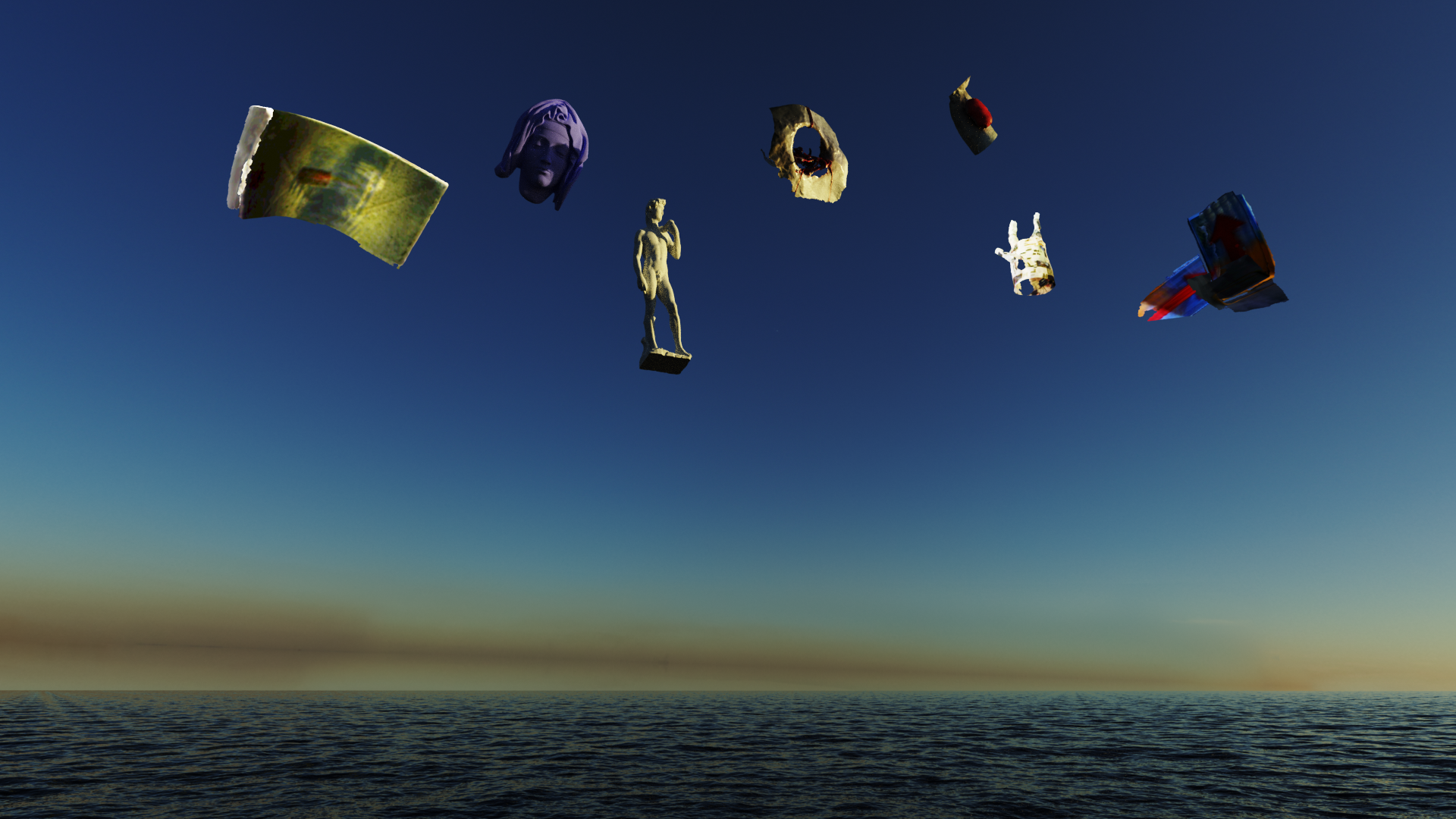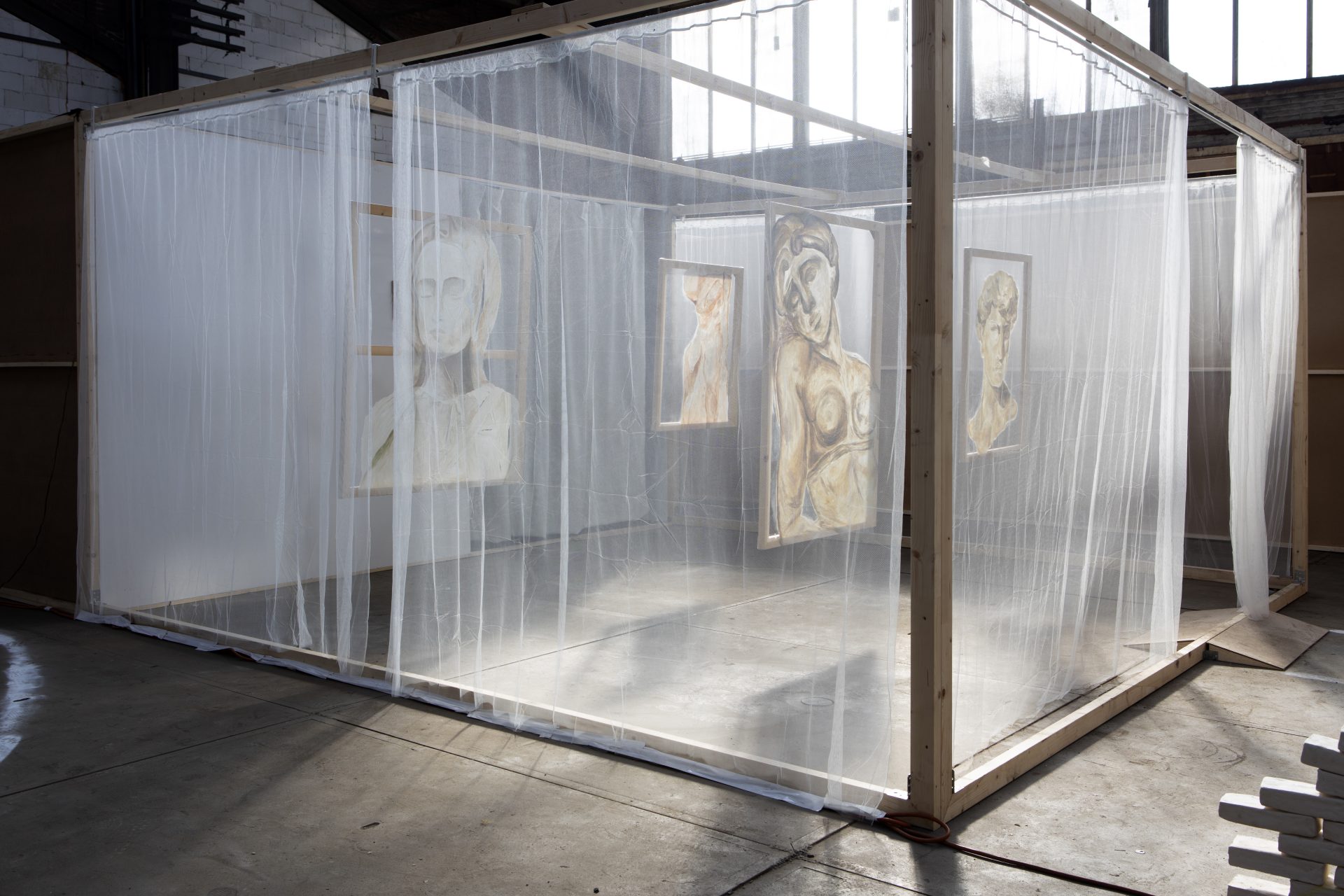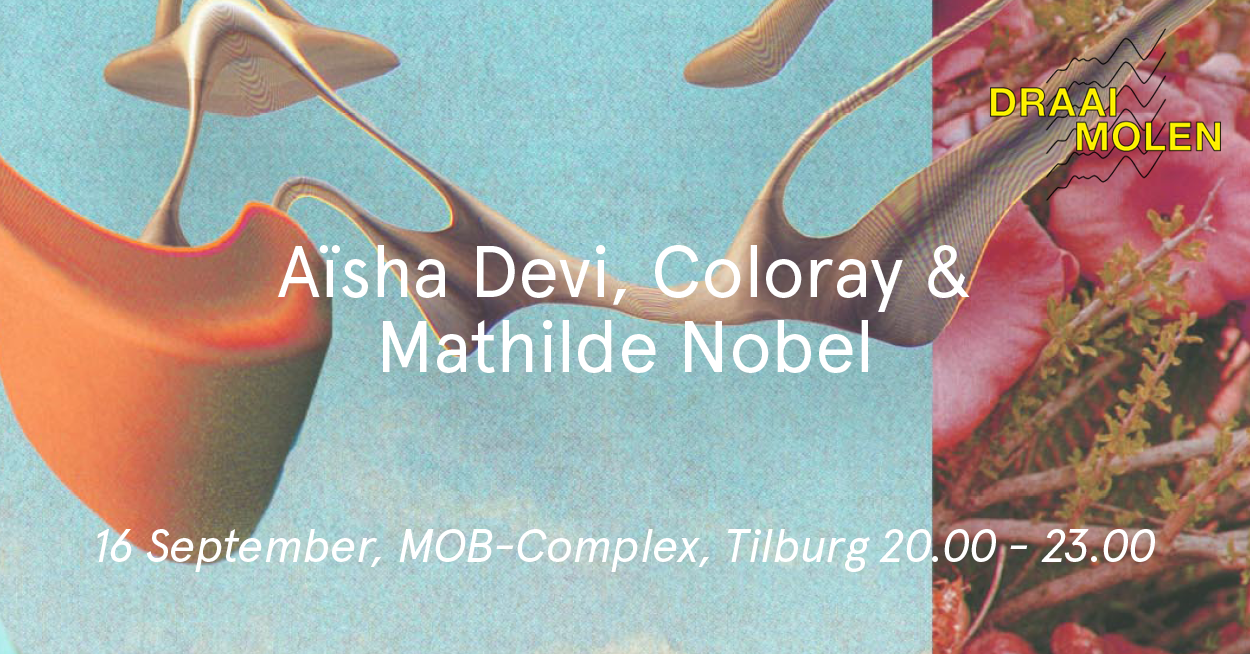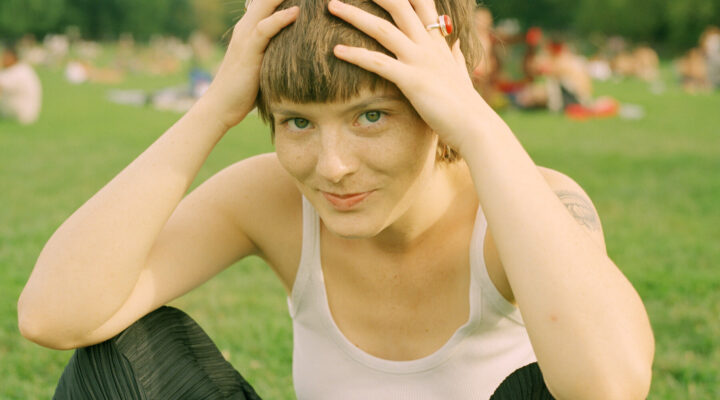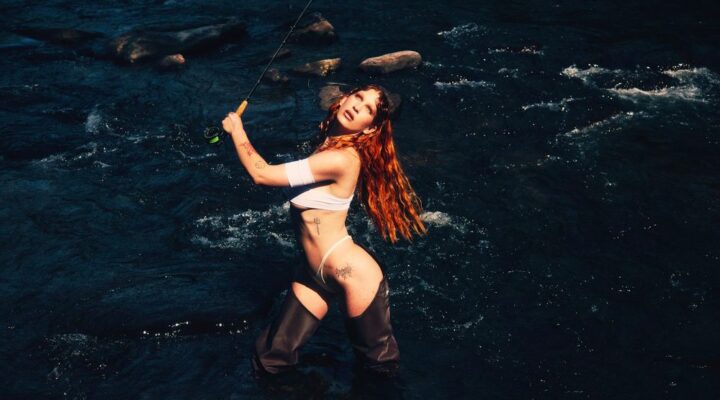An Interview with Mathilde Nobel
Text by Sydney van Nieuwaal
Photos by Sid Dankers or courtesy of Mathilde Nobel
Mathilde Nobel creates her music in reveries, exploring time and space, by (briefly) losing sense of those for herself. That process vegetates haunting tracks, which are slow-burning yet fiercely driven and pushed by a vigor that seems to sift through era’s. An echo of something long-lost, captured, cloaked and coated in another context. Her interest and exploration of this subject matter found genesis in art academy, and eventually found its way onto record, all along a meandering, time-bending journey. Just prior to her debut performance for This Is Not Draaimolen Festival 2021 I had a chat with Mathilde.

Hi Mathilde, thank you for speaking with us! How are you?
I am very well, thanks for asking! I’m busy as hell, but all for good reason. It’s very time consuming to prepare myself for my first live show. However, I really love every bit of it.
I see. How are the preparations going?
At the moment, I have lots of singing lessons with my vocal coach, Rianne Wilbers. Those really help me a lot. Also, I’m working on some other projects. For instance, I’m currently making a walkable composition with Strijbos and Van Rijswijk at STRP Eindhoven. Also, I’ll participate at an artist residency, organised by Tom Swart from Imaginary Landscape. as I said before, I’m preparing for my debut liveshow at Draaimolen Festival! I’m so excited.
I’ve read that you dispersed some CD’s next to your graduation installation for St. Joost. What sounds did those compact discs carry?
May I say that I’m very happy you asked about my first album? I haven’t really talked with anybody about those songs, while they still mean so much to me. I get nostalgic instantly. That album had grown from me starting the first year of learning how to produce music, and the four years following. I would say that those sounds are really emotional, but without a lot of production skills, haha. The songs clearly are my journey of expressing myself through music – with reverb all over the place and stretched rhythms made by field recordings. There’s some attempt to sing, but I recall that I was very scared to bring out my own voice. So, it’s mainly instrumentals. For me, these songs represent all the heavy emotions. I needed, and still need, a space or medium where the big feeling can just be. Without any filter.

You’ve stated that the increasing time you spent on music production started reflecting on your art practices. How particularly?
Well, I have less time to practice painting or 3D animation now. A while ago I was invited for this art residency in Heerlen (for Intro in Situ) and I loved it so much, because I could make something other than only music again! I would love to see these two disciplines get more in balance, but at the same time I also feel like I shouldn’t feel guilty about not painting daily… Or weekly, or sometimes monthly. I’ve been practicing making images for the past four years and it’s okay to have a break and solely focus on music. I still reflect on the art I made and make. I’ll always keep thinking about the intention of creation and how I should start. For example, I would love to make videos and 3D animations for other artists. So, hopefully this will happen in the future.
Themes that pop up quite frequently in your work are history and time – specifically the fragmentation and classification of those. How and when did you start engaging with this subject matter?
To be honest, this was a very weird process. The first 2,5 years of art school I was exclusively making abstract paintings. At the start of my third year, I was doing a semester abroad, in Vancouver. One day I just didn’t know what to paint anymore. I felt empty. There was this picture of my grandpa when he was approximately 20 years old. I just started to paint his portrait, and for some reason, it didn’t stop. I was done with abstract painting from one day to the other, and started focusing on portraits only. Then I got bored of that as well, because I didn’t know why I was doing it. At the end of my third year I was searching for a change of subject and was staring into historical books of the renaissance. Somehow I felt like I needed to go back to the origin of painting, and understand what it means to paint. The more classical approach was to sketch these sculptures and learn from the old masters so to say. This isn’t something we learn at the art academy anymore. So, I picked some sculptures of Michelangelo as an example and started to paint his work. For some reason, it just clicked for me. The reason I was painting my dead grandpa and these renaissance sculptures was because I felt like these images will always mean something different, besides this nostalgic feeling of a certain classification of time. So for me personally, I really wanted to discover what these old images meant for me in the ‘now’ and how these images can be revisited in their context.
How do you research these themes?
As I was saying, I started to paint sculptures of Michelangelo, and by doing so, I already was making some statements. To recreate historical and often iconic sculptures is a research within itself. So, what happens if I put a very iconic sculpture, like Michelangelo’s David, into the digital realm as a 3D model? What does this particular sculpture mean more than its historical context? I discovered that the medium I use to research something, like oil paint or film on mini DV, gives another layer of meaning to what David can truly be and how it can be seen in a different light than historically given. Besides making a lot of paintings, films and animations, I was reading Postmodernism, or, the Cultural Logic of Late Capitalism by Fredrich Jameson and John Berger’s Ways of Seeing. These theoretical approaches of what I was researching really helped in forming my understanding of time. But, it’s still an ongoing process. Sometimes I feel like a catfish, as there’s so much more I don’t understand about time and my statements can be very contradictory.
I catch these themes in your audio, visual and textual output. Could you tell me a bit more about the way these themes find their way in the sonics and song-structures you employ?
I think that music is a very pure and emotional output, without too much (direct) theoretical thinking. Songs really float in my head. Lyrically as well. Usually when I’m doing something ordinary – like cleaning my house, or doing boxing training, or showering – some notes just pop into my head. There we have the beginning of a song. For example; ‘Thunder’. While showering, the words just came to me. I rushed to my Tascam recorder and sang the lyrics. There are also songs that I cannot get out of my head, but still aren’t ready to be made in a full song. ‘Stone’ had been in my head for quite a few years and it was just this summer that I was able to produce the song. So, that’s all intuitively. But then, when the songs are finished, I start to reflect and they always rely on this concept or exploration of history and thereby of time. I don’t really think about theory intentionally, but I do feel theoretical concepts when I’m not thinking of them. I guess that counts for everything theoretical: there’s also emotions involved. That’s the whole reason for being interested in certain subjects. So, to go back to your question: I’m not sure how these themes intertwine into the songs. It just happens unconsciously.
Does the exploration of these themes find a way outside of your art and music? For instance; how do you approach the concept of time in your day-to-day life?
With regards to the creation music the themes are explored very intuitively – as I just said. Within my day-to-day life, this approach towards time becomes more practical or emotional. For example; I live on a farm, which originates from the year 1801. While writing this, I’m in the attic of the farm, surrounded by rusty walls and very old wood. The wood is falling apart, showing its layers of time and allowing some air from outside in, as there are some small holes in the ridge. So, I’m literally creating electronic music within this very old structure. This feels a bit too poetic, but it’s automatically an interaction with time. Living in my house will always mean that I’m confronted with history. But also, gardening here is interesting to me, since I discover more and more seeds of different herbs left by the old farmer that still sprout now.
I’ve read your music was created very privately. How do you feel about performing that same music live, allowing direct interaction by others?
I’m anxious and excited at the same time! The songs are all very vulnerable, but at the same time, I feel really strong about sharing it with other people. It’s a very strange feeling that people are now gonna physically see me on stage. The person that carries the music through like a hatch. Sometimes I feel like hiding, but it’s also me who made the songs. This body. This appearance. So, this step is really important for me. Sharing music together gives another meaning and power to the songs. It’s also a relief that the songs will not be private anymore and that I can let go of them to grow and mean something for someone else, sometime. At least, that’s what I hope to achieve.
You speak about historically decontextualising artefacts from where and how in our classification of history they’ve been placed. How do you view the contextualisation and classification of music? Referring to the confines of online streaming, interviews, rating and reviews and taking a stage to perform on?
That’s a very interesting question! I’m actually pretty bad at classifying music or working with genres. I’m getting better at it, but still don’t fully know how to call certain compositions. I’m not saying that classification is bad, even with history. See the contradictory, haha? I guess within music, there are two sides. On one hand it’s very handy to classify music in order to honor the sounds you like, and to organise. For example, there’s a huge difference between pop music from the 70’s and pop music from the current age. On the other hand, working within a certain type of genre, like a lot of DJ’s do, has its limits. Or rather, it feels like it has its limits. I think it’s hard for certain musicians who work within a genre that made them well known, to completely get out of the scene and try something wholly different.
I think genres are very complicated. If you listen to techno as the genre techno, it will have a certain function. But, if you listen to the same techno piece as a piece of art, the song can suddenly be viewed differently, without referring to the structure of the genre techno. So, maybe it would be nice to think about what you want to reach for when you listen to a certain composition. How interesting would it be to perform the same techno composition on a more classical oriented stage? Would we listen to this particular techno the same as its performed in a nightclub? I guess not.
In photoshoots and your music video for ‘Stone’, you can be seen with fully black eyes. Is there any backstory to this specific guise?
The black eyes became a thing when I was making some videos for my graduation. I wanted not to be seen as Mathilde but as a character that represents something else in these videos. When I take in the black contacts I can’t actually see anything. Perhaps that’s the whole point. I think it’s also interesting that a lot of classical statues don’t have definition in their eyeballs. As if you’re not really sure where they’re looking at. That’s an interesting concept of being able to revisit something. You have to look in an unknown direction.
Ok! Is there anything else you would like to share?
I just wanted to say that I loved the interview! Great questions and hope you guys enjoyed it. See you soon hopefully!
Thank you for sharing your answers and thoughts Mathilde!
Mathilde Nobel will perform live at This Is Not Draaimolen Festival 2021, alongside Aïsha Devi & Coloray on the 16th of September. Subbacultcha members get free access to this show. Find more info here!
